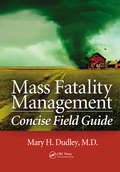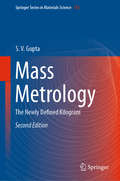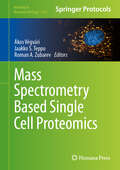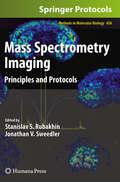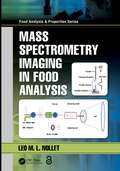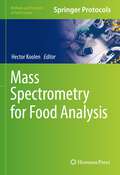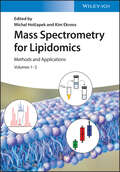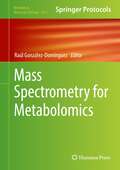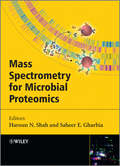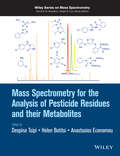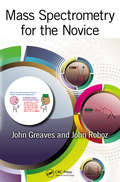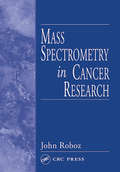- Table View
- List View
Mass Fatality Management Concise Field Guide
by Mary H. DudleyThis student mainstay continues to be organised around constitutional themes, with new material on local elections, the politics of the centre and the limits of state power. Essential for all introductory students of British politics and current affairs.
Mass Metrology (Springer Series in Materials Science #155)
by S. V. GuptaThis second edition of Mass Metrology: The Newly Defined Kilogram has been thoroughly revised to reflect the recent redefinition of the kilogram in terms of Planck’s constant. The necessity of defining the kilogram in terms of physical constants was already underscored in the first edition. However, the kilogram can also be defined in terms of Avogadro’s number, using a collection of ions of heavy elements, by the levitation method, or using voltage and watt balances. The book also addresses the concepts of gravitational, inertial and conventional mass, and describes in detail the variation of acceleration due to gravity. <P><P> Further topics covered in this second edition include: the effect of gravity variations on the reading of electronic balances derived with respect to latitude, altitude and earth topography; the classification of weights by the OIML; and maximum permissible error in different categories of weights prescribed by national and international organizations. The book also discusses group weighing techniques and the use of nanotechnology for the detection of mass differences as small as 10-24 g. Last but not least, readers will find details on the XRCD method for defining the kilogram in terms of Planck’s constant.
Mass Notification and Crisis Communications: Planning, Preparedness, and Systems
by Denise C. WalkerMass communication in the midst of a crisis must be done in a targeted and timely manner to mitigate the impact and ultimately save lives. Based on sound research, real-world case studies, and the author‘s own experiences, Mass Notification and Crisis Communications: Planning, Preparedness, and Systems helps emergency planning professionals create
Mass Spectrometry
by Vincent Stroobant Edmond De HoffmannThe latest edition of a highly successful textbook, Mass Spectrometry, Third Edition provides students with a complete overview of the principles, theories and key applications of modern mass spectrometry. All instrumental aspects of mass spectrometry are clearly and concisely described: sources, analysers and detectors. Tandem mass spectrometry is introduced early on and then developed in more detail in a later chapter. Emphasis is placed throughout the text on optimal utilisation conditions. Various fragmentation patterns are described together with analytical information that derives from the mass spectra.This new edition has been thoroughly revised and updated and has been redesigned to give the book a more contemporary look. As with previous editions it contains numerous examples, references and a series of exercises of increasing difficulty to encourage student understanding. Updates include: Increased coverage of MALDI and ESI, more detailed description of time of flight spectrometers, new material on isotope ratio mass spectrometry, and an expanded range of applications.Mass Spectrometry, Third Edition is an invaluable resource for all undergraduate and postgraduate students using this technique in departments of chemistry, biochemistry, medicine, pharmacology, agriculture, material science and food science. It is also of interest for researchers looking for an overview of the latest techniques and developments.
Mass Spectrometry
by James M. ThompsonIt is estimated that there are about 10 million organic chemicals known, and about 100,000 new organic compounds are produced each year. Some of these new chemicals are made in the laboratory and some are isolated from natural products. The structural determination of these compounds is the job of the chemist. There are several instrumental techniques used to determine the structures of organic compounds. These include NMR, UV/visible, infrared spectroscopy, mass spectrometry, and X-ray crystallography. Of all the instrumental techniques listed, infrared spectroscopy and mass spectrometry are the two most popular techniques, mainly because they tend to be less expensive and give us the most structural information. This book is an introductory text designed to acquaint undergraduate and graduate students with the basic theory and interpretative techniques of mass spectrometry. Much of the material in this text has been used over a period of several years for teaching courses in materials characterization and chemical analysis. It presents the mass spectra of the major classes of organic compounds and correlates the fragmentation pattern of each spectrum with the structural features of the compound it represents. This has been done for hydrocarbons, organic acids, ketones, aldehydes, esters, anhydrides, phenols, amines, and amides. The text discusses the origin of the fragments, techniques, innovations, and applications in mass spectrometry. It is interspersed with many illustrations, examples, an adequate but not overwhelming bibliography, and problems for students. It will serve as a lecture text for a one-semester course in mass spectrometry or can be used to teach the mass spectra portion of a broader course in material characterization and chemical analysis.
Mass Spectrometry
by Jürgen H GrossThis book offers a balanced mixture of practice-oriented information and theoretical background as well as numerous references, clear illustrations, and useful data tables. Problems and solutions are accessible via a special website. This new edition has been completely revised and extended; it now includes three new chapters on tandem mass spectrometry, interfaces for sampling at atmospheric pressure, and inorganic mass spectrometry.
Mass Spectrometry Based Single Cell Proteomics (Methods in Molecular Biology #2817)
by Ákos Végvári Jaakko S. Teppo Roman A. ZubarevThis volume explores the latest advancements made in the field of mass spectrometry (MS) based single cell proteomics. The chapters in this book focus on technologies, methods, and biological applications and together cover the entire single cell proteomics analysis workflow, from sample collection and preparation through liquid chromatographic separation and mass spectrometric data acquisition to data analysis and interpretation. Written in the highly successful Methods in Molecular Biology series format, chapters include introductions to their respective topics, lists of the necessary materials and reagents, step-by-step, readily reproducible laboratory protocols, and tips on troubleshooting and avoiding known pitfalls. Cutting-edge and authoritative, Mass Spectrometry Based Single Cell Proteomics: Methods and Protocols is a valuable resource for all researchers interested in using these technologies and methods in their laboratories to continue making biological discoveries in this important field.
Mass Spectrometry Basics
by Christopher G. Herbert Robert A.W. JohnstoneMass Spectrometry Basics provides authoritative yet plain-spoken explanations of the basic concepts of this powerful analytical method without elaborate mathematical derivations. The authors describe processes, applications, and the underlying science in a concise manner supported by figures and graphics to further comprehension. The text provides
Mass Spectrometry Data Analysis in Proteomics
by Rune MatthiesenMass Spectrometry Data Analysis in Proteomics is an in-depth guide to the theory and practice of analyzing raw mass spectrometry (MS) data in proteomics. As MS is a high throughput technique, proteomic researchers must attend carefully to the associated field of data analysis, and this volume outlines available bioinformatics programs, algorithms, and databases available for MS data analysis. General guidelines for data analysis using search engines such as Mascot, Xtandem, and VEMS are provided, with specific attention to identifying poor quality data and optimizing search parameters. Several different types of MS data are discussed, followed by a description of optimal methods for conversion of raw data into peak lists for input to search engines. Choosing the most accurate and complete databases is emphasized, and a report of available sequence databases is included. Methods for assembling expressed sequence tags (ESTs) into assembled nonredundant databases are provided, along with protocols for further processing the sequences into a format suitable for MS data. Mass Spectrometry Data Analysis in Proteomics describes publicly available applications whenever possible.
Mass Spectrometry Data Analysis in Proteomics
by Rune MatthiesenSince the publishing of the first edition, the methodologies and instrumentation involved in the field of mass spectrometry-based proteomics has improved considerably. Fully revised and expanded, Mass Spectrometry Data Analysis in Proteomics, Second Edition presents expert chapters on specific MS-based methods or data analysis strategies in proteomics. The volume covers data analysis topics relevant for quantitative proteomics, post translational modification, HX-MS, glycomics, and data exchange standards, among other topics. Written in the highly successful Methods in Molecular Biology series format, chapters include brief introductions to their respective subjects, lists of the necessary materials and reagents, step-by-step, readily reproducible laboratory protocols, and tips on troubleshooting and avoiding known pitfalls.<P><P> Updated and authoritative, Mass Spectrometry Data Analysis in Proteomics, Second Edition serves as a detailed guide for all researchers seeking to further our knowledge in the field of proteomics.
Mass Spectrometry Data Analysis in Proteomics (Methods in Molecular Biology #2051)
by Rune MatthiesenThe aim of this new edition is to provide detailed information on each topic and present novel ideas and views that can influence future developments in mass spectrometry-based proteomics. In contrast to the previous editions, this third edition aims to provide the most relevant computational methods, focusing on computational concepts. Written in the highly successful Methods in Molecular Biology series format, chapters include introductions to their respective topics, lists of the necessary materials and reagents, step-by-step, readily reproducible laboratory protocols, and tips on troubleshooting and avoiding known pitfalls. Authoritative and cutting-edge, Mass Spectrometry Data Analysis in Proteomics, Third Edition to ensure successful results in the further study of this vital field.
Mass Spectrometry Handbook
by Michael S. LeeDue to its enormous sensitivity and ease of use, mass spectrometry has grown into the analytical tool of choice in most industries and areas of research. This unique reference provides an extensive library of methods used in mass spectrometry, covering applications of mass spectrometry in fields as diverse as drug discovery, environmental science, forensic science, clinical analysis, polymers, oil composition, doping, cellular research, semiconductor, ceramics, metals and alloys, and homeland security. The book provides the reader with a protocol for the technique described (including sampling methods) and explains why to use a particular method and not others. Essential for MS specialists working in industrial, environmental, and clinical fields.
Mass Spectrometry Imaging
by Jonathan V. Sweedler Stanislav S. RubakhinMass spectrometry (MS) offers unmatched capabilities for the detection, characterization, and identification of a broad range of analytes. Mass spectrometry imaging (MSI) integrates MS data with information on the spatial distributions of the analytes, further enhancing the applicability of MS. In Mass Spectrometry Imaging: Principles and Protocols, expert practitioners from academia, industry, and the clinic contribute cutting-edge protocols describing the application of MSI to investigations of analyte localization in a variety of specimens, from microorganisms to plant and animal tissues. Divided into three sections, this volume presents the principles of MS, current and future trends of MSI, and qualitative and quantitative protocols to measure and identify endogenous metabolites and xenobiotics. An array of MSI approaches and technologies for characterizing peptide and protein distributions are described in detail. Written in the highly successful Methods in Molecular BiologyTM series format, protocol chapters include introductions to their respective topics, lists of the necessary materials and reagents, and step-by-step, readily reproducible laboratory procedures. Also included are notes providing tips to avoid experimental pitfalls and helpful suggestions for method troubleshooting. Comprehensive and up-to-date, Mass Spectrometry Imaging: Principles and Protocols is written for scientists, biological and chemical engineers, and clinicians who are interested in applying MSI in their work and those who would benefit from having detailed experimental guidelines available in a single, convenient source.
Mass Spectrometry Imaging in Food Analysis (Food Analysis & Properties)
by Leo M.L. NolletFood contains various compounds and many technologies exist to analyze those molecules of interest. However, the analysis of the spatial distribution of those compounds using conventional technology, such as liquid chromatography-mass spectrometry or gas chromatography-mass spectrometry is difficult. Mass spectrometry imaging (MSI) is a mass spectrometry technique to visualize the spatial distribution of molecules, as biomarkers, metabolites, peptides or proteins by their molecular masses. Despite the fact that MSI has been generally considered a qualitative method, the signal generated by this technique is proportional to the relative abundance of the analyte and so quantification is possible. Mass Spectrometry Imaging in Food Analysis, a volume in the Food Analysis and Properties Series, explains how the novel use of matrix-assisted laser desorption/ionization mass spectrometry imaging (MALDI-MSI) will be an ideal complementary approach. MALDI-MSI is a two-dimensional MALDI-MS technology that can detect compounds in a tissue section without extraction, purification, separation, or labeling. It can be used to visualize the spatial distribution of biomolecules in foods. Features: Explains the novel use of matrix-assisted laser desorption/ionization mass spectrometry imaging in food analysis Describes how MALDI-MSI will be a useful technique for optical quality assurance. Shows how MALDI-MSI detects food contaminants and residues Covers the historical development of the technology While there are a multitude of books on mass spectrometry, none focus on food applications and thus this book is ideally suited to food scientists, food industry personnel engaged in product development, research institutions, and universities active in food analysis or chemical analysis. Also available in the Food Analysis and Properties Series: Food Aroma Evolution: During Food Processing, Cooking, and Aging, edited by Matteo Bordiga and Leo M.L. Nollet (ISBN: 9781138338241) Ambient Mass Spectroscopy Techniques in Food and the Environment, edited by Leo M.L. Nollet and Basil K. Munjanja (ISBN: 9781138505568) Hyperspectral Imaging Analysis and Applications for Food Quality, edited by N.C. Basantia, Leo M.L. Nollet, and Mohammed Kamruzzaman (ISBN: 9781138630796) For a complete list of books in this series, please visit our website at: www.crcpress.com/Food-Analysis--Properties/book-series/CRCFOODANPRO
Mass Spectrometry Imaging of Small Molecules
by Lin HeMass Spectroscopy Imaging (MSI) has emerged as an enabling technique to provide insight into the molecular entities within cells, tissues and whole-body samples and to understand inherent complexities within biological metabolomes. In Mass Spectrometry Imaging of Small Molecules: Methods and Protocols, experts in the MSI field present techniques for 2D and 3D visualization and quantification of a wide array of small molecular species present in biologically relevant samples. Chapters provide detailed operational instructions from sample preparation to method selection, from comparative quantification to structural identification and from data collection to visualization of small molecule mapping in complex samples. Written in the successful Methods in Molecular Biology series format, chapters include introductions to their respective topics, lists of the necessary materials and reagents, step-by-step, readily reproducible protocols and notes on troubleshooting and avoiding known pitfalls. Authoritative and easily accessible, Mass Spectrometry Imaging of Small Molecules: Methods and Protocols aims to bring the rapidly maturing methods of metabolic imaging to life science researchers and to minimize technical intimidation in adapting new technological platforms in biological research.
Mass Spectrometry Imaging of Small Molecules: Methods and Protocols (Methods in Molecular Biology #2437)
by Young-Jin LeeThis volume presents updated methods and new developments in the field of mass spectrometry imaging. Chapters guide readers through four parts covering imaging, software, data analysis, new instrumentation, and new methodological approaches. Written in the highly successful Methods in Molecular Biology series format, chapters include introductions to their respective topics, lists of the necessary materials and reagents, step-by-step, readily reproducible laboratory protocols, and tips on troubleshooting and avoiding known pitfalls. Authoritative and cutting-edge, Mass Spectrometry Imaging of Small Molecules aims to be a useful practical guide to researchers to help further their study in this field.
Mass Spectrometry and Stable Isotopes in Nutritional and Pediatric Research
by Henk SchierbeekA guide for scientists, pediatricians and students involved in metabolic studies in pediatric research Addresses the availability of modern analytical techniques and how to apply these techniques in metabolic studies Covers the whole range of available mass spectrometric techniques used for metabolic studies including Stable Isotope Methodology Presents the relevance of mass spectrometry and stable isotope methodology in pediatric research covering applications in Nutrition, Obesity, Metabolic Disorders, and Kidney Disorders Focuses on the interactions between nutrients and the endogenous metabolism within the body and how these factors affect the health of a growing infant
Mass Spectrometry for Drug Discovery and Drug Development (Wiley Series on Mass Spectrometry #46)
by Walter A. KorfmacherFacilitates the discovery and development of new, effective therapeutics With coverage of the latest mass spectrometry technology, this book explains how mass spectrometry can be used to enhance almost all phases of drug discovery and drug development, including new and emerging applications. The book's fifteen chapters have been written by leading pharmaceutical and analytical scientists. Their contributions are based on a thorough review of the current literature as well as their own experience developing new mass spectrometry techniques to improve the ability to discover and develop new and effective therapeutics. Mass Spectrometry for Drug Discovery and Drug Development begins with an overview of the types of mass spectrometers that facilitate drug discovery and development. Next it covers: HPLC–high-resolution mass spectrometry for quantitative assays Mass spectrometry for siRNA Quantitative analysis of peptides Mass spectrometry analysis of biological drugs Applications that support medicinal chemistry investigations Mass spectrometry imaging and profiling Throughout the book, detailed examples underscore the growing role of mass spectrometry throughout the drug discovery and development process. In addition, images of mass spectra are provided to explain how results are interpreted. Extensive references at the end of each chapter guide readers to the primary literature in the field. Mass Spectrometry for Drug Discovery and Drug Development is recommended for readers in pharmaceutics, including medicinal chemists, analytical chemists, and drug metabolism scientists. All readers will discover how mass spectrometry can streamline and advance new drug discovery and development efforts.
Mass Spectrometry for Food Analysis (Methods and Protocols in Food Science)
by Hector KoolenThis volume details protocols on mass spectrometry and associated techniques. Chapters guide readers through micro- and macronutrients analysis, mass spectrometry-related methodologies, direct insertion, matrix-assisted laser desorption ionization (MALDI), gas chromatography (uni- and bi-dimensional), liquid chromatography, plasma mass spectrometry (ICP-MS), and analyses in food samples. Authoritative and cutting-edge, Mass Spectrometry for Food Analysis aims to provide comprehensive and updated state-of-art methodologies and models for food analysis.
Mass Spectrometry for Lipidomics: Methods and Applications
by Kim Ekroos Michal HolčapekMass Spectrometry for Lipidomics All-in-one guide to successful lipidomic analysis, combining the latest advances and best practices from academia, industry, and clinical research Mass Spectrometry for Lipidomics presents a systematic overview of lipidomic analysis, covering established standards of lipid analysis, available technology, and key lipid classes, as well as applications in basic research, medicine, pharma, and the food industry. Through connecting recent technological advances with key application areas, this unique guide bridges the gap between academia and industry by translating the vast body of knowledge that has been gained in the past decade into much-needed practical advice for novices as well as routine users. Edited by the president and vice-president of the International Lipidomics Society with contributions from the top experts in lipid analysis, Mass Spectrometry for Lipidomics covers a wide range of key topics, including: Aspects of sample preparation, separation methods, different mass spectrometry modes, as well as identification and quantitation, including the use of bioinformatics tools for data analysis Identification, quantitation and profiling of lipids in different types of biological samples Analytical approaches for all major classes of biological lipids, from fatty acids to phospholipids to sterols Novel applications in biological research, clinical diagnostics, as well as food and crop science For analytical chemists, biochemists, clinical chemists, and analytical laboratories and hospitals, Mass Spectrometry for Lipidomics presents a comprehensive and authoritative overview of the subject, with unmatched expertise from practicing professionals actively involved in the latest research.
Mass Spectrometry for Metabolomics (Methods in Molecular Biology #2571)
by Raúl González-DomínguezThis detailed volume provides a comprehensive overview of state-of-the-art metabolomics methods based on mass spectrometry (MS), and their application in food, nutrition, and biomedical research. The chapters assembled herein cover hot topics related to sample preparation, chromatographic and electrophoretic separation, MS-based analysis, as well as data processing and analysis. Written for the highly successful Methods in Molecular Biology series, chapters include introductions to their respective topics, lists of the necessary materials and reagents, step-by-step and readily reproducible laboratory protocols, and tips on troubleshooting and avoiding known pitfalls. Authoritative and cutting-edge, Mass Spectrometry for Metabolomics serves as a timely guide for chemists, biochemists, biologists, nutritionists, clinicians, and other experts working in the growing and exciting field of metabolomics.
Mass Spectrometry for Microbial Proteomics
by Saheer E. Gharbia Haroun N. ShahNew advances in proteomics, driven largely by developments in mass spectrometry, continue to reveal the complexity and diversity of pathogenic mechanisms among microbes that underpin infectious diseases. Therefore a new era in medical microbiology is demanding a rapid transition from current procedures to high throughput analytical systems for the diagnosis of microbial pathogens.This book covers the broad microbiological applications of proteomics and mass spectrometry. It is divided into six sections that follow the general progression in which most microbiology laboratories are approaching the subject -Transition, Tools, Preparation, Profiling by Patterns, Target Proteins, and Data Analysis.
Mass Spectrometry for the Analysis of Pesticide Residues and their Metabolites
by Helen Botitsi Despina Tsipi Anastasios EconomouProvides an overview of the use of mass spectrometry (MS) for the analysis of pesticide residues and their metabolites. Presents state of the-art MS techniques for the identification of pesticides and their transformation products in food and environment Covers important advances in MS techniques including MS instrumentation and chromatographic separations (e.g. UPLC, HILIC, comprehensive GCxGC) and applications Illustrates the main sample preparation techniques (SPE, QuEChERS, microextraction) used in combination with MS for the analysis of pesticides Describes various established and new ionization techniques as well as the main MS platforms, software tools and mass spectral libraries
Mass Spectrometry for the Novice
by John Greaves John RobozWith usage of mass spectrometry continually expanding, an increasing number of scientists, technicians, students, and physicians are coming into contact with this valuable technique. Mass spectrometry has many uses, both qualitative and quantitative, from analyzing simple gases to environmental contaminants, pharmaceuticals, and complex biopolymers. The extraordinary versatility can make mass spectrometers daunting to novices. Consequently, new users would benefit greatly from an understanding of the basic concepts as well as the processes that occur in these instruments. Mass Spectrometry for the Novice provides exactly that, with detailed, straightforward descriptions and clear illustrations of principles of operations and techniques.The book begins with an overview that includes essential definitions and then provides information on the components of and the strategies used in the most common instruments. The authors discuss the methodologies available, classes of compounds analyzed, and the types of data that can be generated. A group of representative applications from published articles is summarized, demonstrating the diversity of mass spectrometry. The authors also condense the essentials of the topic into one invaluable chapter that provides a set of concise take-home messages on all aspects of mass spectrometry. The final section provides a collection of resources including books, reviews, and useful websites.Using simple language, new color figures, clever cartoons, and assuming no prior knowledge, this book provides a readily understandable entrée to mass spectrometry. Downloadable resources with selected figures and cartoons is included.
Mass Spectrometry in Cancer Research
by John RobozCancer research is becoming multidisciplinary. The complex structural and therapeutic problems require synergistic approaches employing an assortment of biochemical manipulations, chromatographic or electrophoretic separations, sequencing strategies, and � more and more mass spectrometry.Mass Spectrometry in Cancer Research provides a broad
